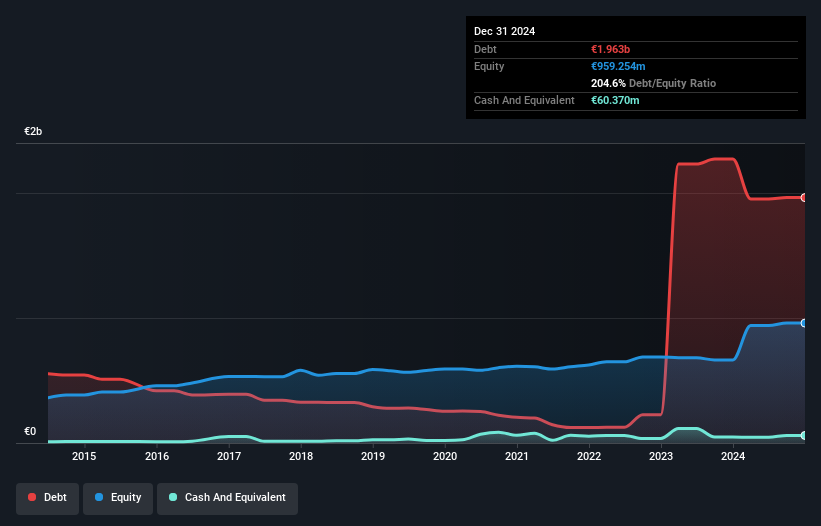- Belgium
- /
- Wireless Telecom
- /
- ENXTBR:OBEL
Here's Why Orange Belgium (EBR:OBEL) Is Weighed Down By Its Debt Load

David Iben put it well when he said, 'Volatility is not a risk we care about. What we care about is avoiding the permanent loss of capital.' When we think about how risky a company is, we always like to look at its use of debt, since debt overload can lead to ruin. Importantly, Orange Belgium S.A. (EBR:OBEL) does carry debt. But the more important question is: how much risk is that debt creating?
We've discovered 2 warning signs about Orange Belgium. View them for free.Why Does Debt Bring Risk?
Debt and other liabilities become risky for a business when it cannot easily fulfill those obligations, either with free cash flow or by raising capital at an attractive price. If things get really bad, the lenders can take control of the business. While that is not too common, we often do see indebted companies permanently diluting shareholders because lenders force them to raise capital at a distressed price. Having said that, the most common situation is where a company manages its debt reasonably well - and to its own advantage. The first step when considering a company's debt levels is to consider its cash and debt together.
How Much Debt Does Orange Belgium Carry?
The image below, which you can click on for greater detail, shows that Orange Belgium had debt of €1.96b at the end of December 2024, a reduction from €2.27b over a year. On the flip side, it has €60.4m in cash leading to net debt of about €1.90b.

How Healthy Is Orange Belgium's Balance Sheet?
According to the last reported balance sheet, Orange Belgium had liabilities of €772.7m due within 12 months, and liabilities of €2.34b due beyond 12 months. Offsetting these obligations, it had cash of €60.4m as well as receivables valued at €340.3m due within 12 months. So its liabilities total €2.72b more than the combination of its cash and short-term receivables.
This deficit casts a shadow over the €1.07b company, like a colossus towering over mere mortals. So we definitely think shareholders need to watch this one closely. After all, Orange Belgium would likely require a major re-capitalisation if it had to pay its creditors today.
Check out our latest analysis for Orange Belgium
In order to size up a company's debt relative to its earnings, we calculate its net debt divided by its earnings before interest, tax, depreciation, and amortization (EBITDA) and its earnings before interest and tax (EBIT) divided by its interest expense (its interest cover). Thus we consider debt relative to earnings both with and without depreciation and amortization expenses.
While we wouldn't worry about Orange Belgium's net debt to EBITDA ratio of 3.5, we think its super-low interest cover of 1.4 times is a sign of high leverage. In large part that's due to the company's significant depreciation and amortisation charges, which arguably mean its EBITDA is a very generous measure of earnings, and its debt may be more of a burden than it first appears. It seems clear that the cost of borrowing money is negatively impacting returns for shareholders, of late. However, one redeeming factor is that Orange Belgium grew its EBIT at 15% over the last 12 months, boosting its ability to handle its debt. There's no doubt that we learn most about debt from the balance sheet. But ultimately the future profitability of the business will decide if Orange Belgium can strengthen its balance sheet over time. So if you want to see what the professionals think, you might find this free report on analyst profit forecasts to be interesting.
Finally, while the tax-man may adore accounting profits, lenders only accept cold hard cash. So it's worth checking how much of that EBIT is backed by free cash flow. Over the last three years, Orange Belgium saw substantial negative free cash flow, in total. While investors are no doubt expecting a reversal of that situation in due course, it clearly does mean its use of debt is more risky.
Our View
On the face of it, Orange Belgium's conversion of EBIT to free cash flow left us tentative about the stock, and its level of total liabilities was no more enticing than the one empty restaurant on the busiest night of the year. But at least it's pretty decent at growing its EBIT; that's encouraging. After considering the datapoints discussed, we think Orange Belgium has too much debt. That sort of riskiness is ok for some, but it certainly doesn't float our boat. When analysing debt levels, the balance sheet is the obvious place to start. But ultimately, every company can contain risks that exist outside of the balance sheet. To that end, you should learn about the 2 warning signs we've spotted with Orange Belgium (including 1 which doesn't sit too well with us) .
If, after all that, you're more interested in a fast growing company with a rock-solid balance sheet, then check out our list of net cash growth stocks without delay.
New: AI Stock Screener & Alerts
Our new AI Stock Screener scans the market every day to uncover opportunities.
• Dividend Powerhouses (3%+ Yield)
• Undervalued Small Caps with Insider Buying
• High growth Tech and AI Companies
Or build your own from over 50 metrics.
Have feedback on this article? Concerned about the content? Get in touch with us directly. Alternatively, email editorial-team (at) simplywallst.com.
This article by Simply Wall St is general in nature. We provide commentary based on historical data and analyst forecasts only using an unbiased methodology and our articles are not intended to be financial advice. It does not constitute a recommendation to buy or sell any stock, and does not take account of your objectives, or your financial situation. We aim to bring you long-term focused analysis driven by fundamental data. Note that our analysis may not factor in the latest price-sensitive company announcements or qualitative material. Simply Wall St has no position in any stocks mentioned.
About ENXTBR:OBEL
Orange Belgium
Engages in the provision of telecommunication services in Belgium and Luxembourg.
Moderate growth potential with acceptable track record.
Similar Companies
Market Insights
Community Narratives




